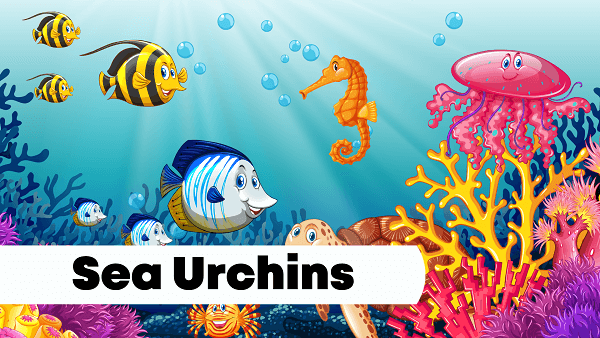Sea Urchins Overview
Appearance
Sea urchins are marine echinoderms with spherical to flattened bodies covered in a protective, spiny exoskeleton. Their spines are often long and slender, radiating outward from a central point. These spines can vary in color, from black and brown to vibrant hues of purple and green.
The mouth of the sea urchin is located on the underside and is surrounded by a set of specialized feeding appendages called “tube feet.” Their overall appearance combines a captivating blend of textures and colors, adapted for life in diverse underwater ecosystems.
Origins And Evolution
Sea urchins have origins dating back over 400 million years, with fossil evidence from the Ordovician period. They belong to the phylum Echinodermata, showcasing their evolutionary kinship with starfish and sea cucumbers.
These echinoderms have evolved from bilateral ancestors into their present radial symmetry, characterized by a spherical or flattened body encased in a spiny exoskeleton.
Over time, they’ve developed a highly specialized water vascular system, intricate mouthparts known as Aristotle’s lantern, and unique adaptations for grazing on algae and detritus. Sea urchins have adapted to diverse marine environments, from shallow coastal waters to the deep sea, making them a resilient and enduring part of the marine ecosystem.
Behavior and Lifestyle
Sea urchins are primarily herbivores, grazing on algae and detritus using their specialized mouthparts called Aristotle’s lantern.
They move slowly using their tube feet and can often be found clinging to rocks or substrates. Some species exhibit solitary behavior, while others form aggregations in areas with abundant food sources. They are essential herbivores in marine ecosystems, influencing the distribution and abundance of algae.
Scientific Classification
- Kingdom: Animalia
- Phylum: Echinodermata
- Class: Echinoidea
Locations
- Coastal waters
- Coral reefs
- Rocky shores
- Kelp forests
- Seagrass beds
- Sandy bottoms
- Deep-sea environments
- Intertidal zones
- Tropical oceans
- Temperate seas
Fast Facts
- Name: Sea Urchins
- Scientific Name: Class Echinoidea
- Habitat: Marine environments worldwide
- Diet: Algae and detritus
- Physical Features: Spiny exoskeleton, tube feet
- Nocturnal: Some are nocturnal
- Solitary: Often solitary creatures
- Unique Order: Varied echinoid orders
- Lifespan: Varies by species
- Conservation Status: Species-dependent concerns
- Fun Facts: Aristotle’s lantern, herbivorous grazers.
Physical Characteristics
- Color: Various, often vibrant
- Skin Type: Spiny exoskeleton protection
- Top Speed: Slow-moving creatures
- Lifespan: Species-dependent, several years
- Weight: Variable, typically lightweight
- Length: Range of sizes
- Age of Sexual Maturity: Species-specific, variable
- Age of Weaning: Not applicable, marine organisms.
Sea Urchins FAQs
What are sea urchins?
Sea urchins are marine echinoderms characterized by their spherical bodies covered in spines.
Are sea urchins related to starfish?
Yes, they are both echinoderms and share a common ancestry within the phylum Echinodermata.
What do sea urchins eat?
Sea urchins are herbivores, primarily feeding on algae, kelp, and detritus.
Do sea urchins have predators?
Yes, they are preyed upon by various marine animals, including sea otters, sea birds, and some fish species.
Can sea urchins regenerate their spines?
Yes, they can regenerate lost spines, similar to how starfish can regenerate limbs.
covering their bodies, although the length and density of the spines can vary.
Are sea urchins dangerous to humans?
Some sea urchin species have venomous spines that can cause painful injuries if stepped on or touched.
Are sea urchins important for ecosystems?
Yes, they play a crucial role in marine ecosystems by controlling algae growth and providing food for various predators.
